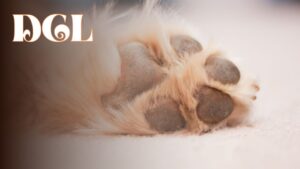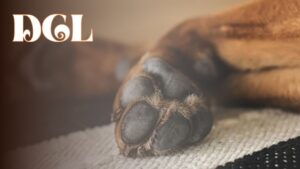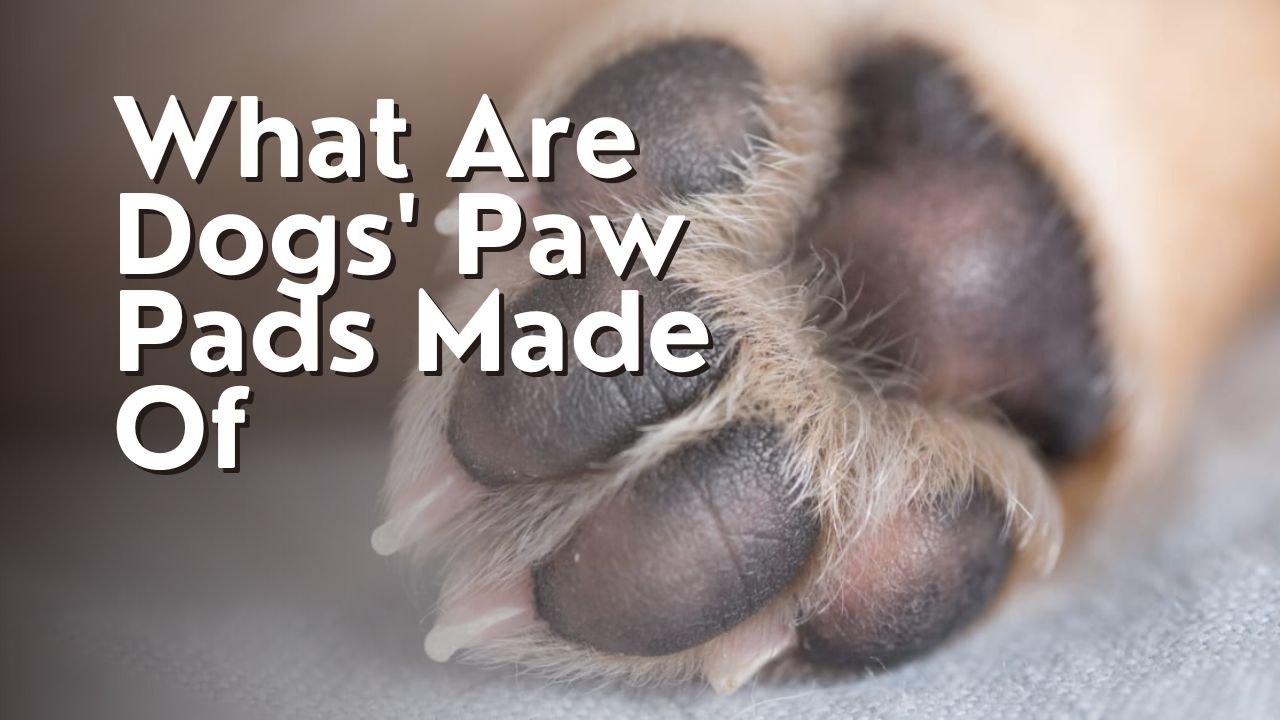Hey there, dog lovers!
Have you ever wondered what your furry friend’s paw pads are made of? Well, in this article, I’ll be diving into the structure, composition, and functions of those adorable little cushions on the bottom of your pup’s paws.
We’ll also explore how these paw pads help with movement and discuss some tips for caring and maintaining them.
So, let’s get started and uncover the secrets of what dogs’ paw pads are made of!
Structure and Composition of Dog Paw Pads
You’ll be interested to know that dogs’ paw pads are made up of a tough, thick layer of skin. These unique structures serve as protective cushions for dogs’ paws, allowing them to walk, run, and play on various terrains. The composition of paw pads includes a combination of fat, collagen, and sweat glands.
The outer layer of a dog’s paw pad is covered in a thick, calloused skin that acts as a natural barrier against rough surfaces. This tough skin is designed to withstand the constant pressure and friction that dogs put on their paws while moving. Underneath this outer layer, there is a layer of fat that provides additional cushioning and insulation, protecting the sensitive tissues and bones within the paw.
Collagen, a protein found in connective tissues, is also present in the paw pads. It gives the pads their strength and elasticity, allowing them to flex and absorb shock. This flexibility is crucial for dogs as they navigate different terrains and encounter various obstacles.
Additionally, dogs’ paw pads contain sweat glands that help regulate their body temperature. Unlike humans, dogs don’t have sweat glands all over their bodies, so their paw pads play a significant role in cooling them down through perspiration.
In conclusion, dogs’ paw pads are a remarkable combination of tough skin, fat, collagen, and sweat glands. These unique structures enable dogs to walk, run, and explore their surroundings without discomfort or injury.

Functions of Dog Paw Pads
Explore the various functions of your furry friend’s paw pads. These incredible structures serve multiple purposes beyond just providing traction.
One of the primary functions of dog paw pads is shock absorption. When dogs walk, run, or jump, their paw pads help to cushion their joints and protect them from the impact of their movements. This is especially important for active dogs who engage in high-energy activities like agility training or playing fetch.
Additionally, paw pads act as insulation. They help to regulate the temperature of a dog’s paws, keeping them warm in cold weather and cool in hot weather. This is crucial for dogs who live in extreme climates or spend a lot of time outdoors. Paw pads also help dogs maintain their balance. The rough texture of the pads provides traction on various surfaces, preventing slips and falls.
Furthermore, dog paw pads have sweat glands that help with cooling. Dogs do not have sweat glands all over their bodies like humans do, so they rely on their paw pads to release excess heat. These sweat glands also release a scent that dogs use for marking their territory.
In conclusion, dog paw pads are remarkable structures that serve multiple functions. They provide shock absorption, insulation, balance, and even help with cooling. So the next time you see your furry friend’s paw pads, remember to appreciate their incredible versatility.
How Dog Paw Pads Help with Movement
When it comes to movement, dog paw pads play a crucial role.
As I walk or run, my paw pads provide traction and grip, allowing me to maintain stability on various surfaces.
Additionally, my paw pads act as shock absorbers, cushioning the impact of each step and reducing strain on my joints.
Lastly, these pads help me navigate different terrains by providing protection against rough surfaces, hot pavement, or sharp objects.
Walking and Running
Dogs’ paw pads are made of thick and tough skin that allows them to walk and run comfortably. The skin on their paw pads is specially designed to provide traction and absorb shock. When walking, their paw pads grip the ground, preventing them from slipping. This is especially important when traversing different terrains such as grass, pavement, or rocky surfaces.
The tough skin acts as a barrier, protecting their sensitive paw tissues from hot or cold surfaces, sharp objects, and rough terrain. It also helps to distribute their weight evenly, reducing stress on their joints and bones. Whether they are strolling leisurely or sprinting at full speed, their paw pads support their movements and provide stability, enabling them to navigate their surroundings with ease.
Navigating Different Terrains
You can easily navigate different terrains with the help of your dog’s specially designed paw pads. These pads are made of a tough and thick layer of skin that provides protection and cushioning. They are composed of a combination of fatty tissue and collagen, which gives them their flexibility and durability. The paw pads also contain sweat glands, which help to keep the pads moisturized and prevent them from drying out. This is especially important when walking on rough or hot surfaces. Here is a table highlighting the different types of terrains and how your dog’s paw pads adapt to them:
| Terrain Type | Paw Pad Adaptation |
|---|---|
| Rocky | Thick skin and fatty tissue provide cushioning |
| Sandy | Flexible pads help to grip the loose surface |
| Icy | Paw pads have small bumps for traction |
| Wet | Glands secrete moisture to prevent slipping |
| Hot | Thick skin protects against burns |
With their incredible paw pads, dogs are well-equipped to handle various terrains and ensure a smooth and safe journey for both of you.
Care and Maintenance of Dog Paw Pads
One important aspect of caring for your dog’s paw pads is regularly checking for any signs of injury or irritation. Just like our own feet, dog paw pads can get hurt or develop problems, so it’s crucial to keep them in good condition.
Here are some tips for maintaining your dog’s paw pads:
- Daily inspection: Take a few minutes each day to examine your dog’s paw pads for any cuts, cracks, or foreign objects like thorns or splinters. This will help you catch any issues early on and prevent them from worsening.
- Moisturize: Dry and cracked paw pads can be painful for your furry friend. To keep them soft and supple, apply a pet-safe moisturizer regularly. This will provide relief and protect their paw pads from further damage.
- Protect from extreme temperatures: Hot pavement in the summer and icy roads in the winter can be harsh on your dog’s paw pads. Consider using paw wax or protective booties to shield their feet from extreme temperatures.
- Trim nails: Overgrown nails can affect how your dog walks and put extra strain on their paw pads. Keep their nails trimmed to a safe length to avoid discomfort and potential injuries.
By following these simple steps, you can ensure that your dog’s paw pads stay healthy and pain-free. Remember, caring for their paws is an essential part of being a responsible and loving dog owner.
Common Issues and Remedies for Dog Paw Pads
Regularly checking your dog’s paw pads for signs of injury or irritation is crucial in maintaining their overall paw health. Common issues that can affect a dog’s paw pads include cuts, abrasions, dryness, and cracked pads. These problems can cause discomfort and even lead to infection if left untreated. However, there are remedies available to help alleviate these issues and promote healing.
One common issue is dryness, which can cause the paw pads to become rough and cracked. To remedy this, you can apply a paw balm or moisturizer specifically designed for dogs. These products help to hydrate and soften the paw pads, promoting healing and preventing further damage.
Another problem that dogs may encounter is cuts or abrasions on their paw pads. These can occur from walking on rough surfaces or sharp objects. To treat these injuries, it is important to clean the affected area with a mild antiseptic solution and apply an antibiotic ointment. Bandaging the paw may also be necessary to protect it from further injury and promote healing.
In order to provide a visual representation of the different issues and remedies for dog paw pads, I have created the following table:
| Issue | Remedy |
|---|---|
| Dryness | Apply paw balm or moisturizer |
| Cuts and abrasions | Clean with antiseptic solution, apply antibiotic ointment |
| Cracked pads | Apply paw balm or moisturizer, consider using booties |
By regularly checking your dog’s paw pads and addressing any issues promptly, you can ensure their paw health and overall well-being.

Frequently Asked Questions
Are all dog paw pads made of the same material?
No, all dog paw pads are not made of the same material. The material of a dog’s paw pads can vary depending on the breed, but they are typically made of thick, tough skin.
How do dog paw pads help dogs maintain balance?
Dog paw pads help me maintain balance by providing traction and grip on various surfaces. They have a thick, cushioned layer of skin that acts like shock absorbers, aiding in stability and preventing slips and falls.
Can dog paw pads get injured or damaged easily?
Yes, dog paw pads can be easily injured or damaged. They are made of tough, thick skin, but they can still be cut, burned, or scraped. It’s important to keep them protected and check for any signs of injury.
What are some common signs of paw pad problems in dogs?
Some common signs of paw pad problems in dogs include limping, licking or chewing at the paws, redness or swelling, cuts or abrasions, and reluctance to walk or put weight on the affected paw.
How can dog owners prevent paw pad issues and keep them healthy?
To prevent paw pad issues and keep them healthy, I regularly inspect my dog’s paws for any cuts or abrasions. I also make sure to keep their nails trimmed and avoid walking on hot pavement or rough surfaces.
Conclusion
In conclusion, understanding the structure and composition of dog paw pads is crucial for their proper care and maintenance. These unique pads, made of tough and resilient keratinized skin, serve several important functions in a dog’s movement and balance.
By providing traction, shock absorption, and protection, paw pads enable dogs to navigate various terrains with ease. Regular inspection, moisturization, and addressing any issues promptly will help keep your furry friend’s paw pads healthy and happy for a lifetime of adventures.


